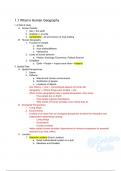1.1 What is Human Geography
I. A field of study
A. Ancient Greeks
1. Geo = the earth
2. Graphien = to write
3. Cartography - art and science of map-making
B. Human Geography
1. Focuses on people
a. Where
b. How similar/different
c. Interactions
2. Looks at human behavior
a. History, Sociology, Economics, Political Science
3. Simplified
a. Earth + People + Impact each other = Patterns
II. Spatial Data
A. Spatial Perspectives
1. Space
2. Patterns
a. Natural and Human environments
b. Distribution of people
c. Locations of objects
- Like History -> time + chronological aspects of human life
Geography -> Where things were located + why
- When human geographers take a spatial perspective, they study:
- How people live on Earth
- How people organize themselves
- Why events of human societies occur where they do
B. Ecological Perspectives
1. Living things
2. Environments
- Looking at an issue from an ecological perspective involves the interactive and
independent relationships among:
- Living things
- Ecosystems
- Human societies
- Helps explain human societies' dependence on diverse ecosystems for essential
resource (e.g. food, water)
C. Location
1. Absolute Location (Exact Location)
a. Exact mathematical location on a grid
b. Meridians and Parallels
, - Example: Budapest, Hungary is on 47.50°N, 19.04°E
- Transportation + GPS (Global Positioning System) = Travel anywhere!
2. Relative Location
a. Location relative to other human or physical features
- Physical Features: climate, landforms, soils, water sources,
vegetation, animal life
- Human features: languages, religions, political systems,
population distribution, architecture, quality of life
- Example: Budapest, Hungary is 134 miles southeast of Vienna, Austria
III. Places and Patterns
A. Place
1. Place name
a. Toponym (e.g. Georgetown, Washington; Santa Barbara, San Diego, San
Francisco, etc indicates Spanish-speaking people used to live near)
2. Site
a. Absolute Location
b. Physical and human characteristics
- Example: landforms, climate, resources
3. Situation
a. Relative Location
- Describes a place’s connections to other places
- Example: Transportation routes, political associations, economic
and cultural ties
4. Absolute Location
a. Latitude and Longitude
B. Patterns
- How things are arranged in a particular space
- Depending on how humans settled and developed a place + needs are for (e.g.
neat or unorganized)
- Helps geographers understand different processes
- Example:
- Agricultural production
- Urban settlement
- Distribution of fast food restaurants in a town
1. Clustering
- Close together
- Density - The number of something in a defined area
- Example: Manila has over 171,000 people/mi2; Province of Davao
del Sur has 850 people/mi2
2. Dispersal/Distribution
- Far apart
- Distribution - The way something is spread out over an area
- Helps describe/analyze organization of people, places,
environments on Earth
, IV. Human Environment
A. Environmental Determinism: Belief that climate and landforms are most powerful forces
shaping human behavior and societal/cultural development
- Example: Flooding area = drought
B. Possibilism: Acknowledges limitations of natural environment, but focuses on role of
human culture to modify + respond to environment to better fit human needs. Not always
a problem
- Example: Power outage -> generator, flooding -> dam, Tsunami -> alerts, Terrace
farming
C. Sustainability: use of Earth’s land and natural resources in ways that ensure they will
continue to be available in the future
- Requires considerations whether natural resource is renewable (nature procure it
faster than people consume)
- Example: renewable energy (wind, solar, bioenergy, hydroelectric)
- Antonym: Nonrenewable (e.g. fossil fuels)
Feeling a strong “sense of place”:
- Emotions attached to an area based on personal experiences
- Sense of place people have for hometown or certain buildings is stronger than it is for
place they do not know
- Tied to their sense of identity
- Example: Baseball stadium
Mental Maps
- Internalized representations of portions of Earth’s surface
- Depends on
- Experiences
- Age
- Where one lives
- Example: What you picture when you think of New England
The study of the flow of:
- People
- Goods
- Information
- Economic, social, political, and cultural effects
Of these movements on societies is an important aspect of human geography
Distance Decay and Time-Space Compression Models
Distance Decay Model:
- States: the farther away one thing is from another, the less interaction the two will have
- Example: The closer you get to an earthquake, the more you are affected
- Relates to friction of time:
- = Distance requires time, effort, and cost to overcome





